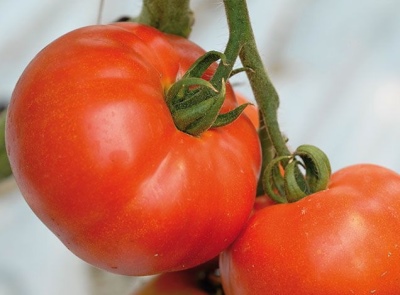
- Authors: Frits Herlaar (Enza Zaden Beheer B.V.)
- Year of approval: 2012
- Name synonyms: Berberana F1
- Category: hybrid
- Growth type: indeterminate
- Appointment: fresh consumption
- Ripening period: early
- Ripening time, days: 95-100
- Growing conditions: for film greenhouses, for greenhouses
- Marketability: high
Every gardener dreams of growing tomatoes without problems in a small greenhouse in the country. To make your dream come true, it is enough to choose the right non-capricious variety that will delight you with delicious homemade tomatoes. This is the Dutch Berberana variety.
Breeding history of the variety
Berberana is a hybrid tomato species developed by Dutch breeders of Enza Zaden Corporation. The variety was approved for use in 2012. Scientists wanted to create an unpretentious variety that gives abundant yields and grows well in all climatic regions in conditions of home film and glazed industrial greenhouses.
Description of the variety
The Berberana tomato is a tall, indeterminate crop type, 180 cm high, requiring formation. The bush is characterized by spreading, moderate amount of dark green foliage with short internodes. The powerful stem is able to withstand the enormous stress of large tomatoes during the fruiting period. In addition, the plant has a powerful root system.
The main qualities of the fruit
Fruits are flat-round, with noticeable ribbing, characterized by considerable size. On average, the weight of one fruit is 170-200 grams. The color of tomatoes is deep red when ripe. When ripe, the tomato has an uneven green tint. The skin of the fruit is dense, but not tough, ensuring the integrity of the tomatoes during storage and transportation.
Taste characteristics
Despite their hybridity, tomatoes are very tasty and juicy. The pulp has a noticeable sweetness, sugar content and fruity velvety. The aroma of the fruit is fresh and pronounced. Refers to universal, therefore, delicious in any form, fresh and in the form of canned sauces, dressings and salads.
Ripening and fruiting
Berberana is an early tomato variety. The period from planting seeds to harvesting the first harvest is 95-100 days. The ripening and fruiting process takes place evenly and for a long time, so fresh tomatoes can be enjoyed for a long time.
Yield
The yield indicator of the variety is high. Subject to agricultural technology, up to 7.8-10.4 kg of tomatoes can be harvested from 1 m2.
The timing of planting seedlings and planting in the ground
Seeds for seedlings are sown in February-March. The ideal soil for this will be the one on which vegetables were previously cultivated (carrots, onions, cabbage). The soil must be decontaminated.
Since this culture does not tolerate picking, it is recommended that sowing be done immediately in separate containers - peat pots. Before sowing, you need to dip the seeds in a saline solution to identify the unsuitable ones, and then disinfect them using potassium permanganate. After sowing, the pots are covered with polyethylene. With the emergence of seedlings, polyethylene is removed, and containers with sprouts are located in a lighted place. This is followed by hardening, after which the seedlings are planted in the ground. Landing in the ground is recommended in mid-May. The soil in the greenhouse must be warmed up.

Growing tomato seedlings is an extremely important process, because it largely depends on whether the gardener can harvest at all. All aspects must be taken into account, from seedbed preparation to planting in the ground.
Landing scheme
Due to the spreading nature of the culture, it is recommended to plant no more than 3 bushes per 1 m2. The optimal planting pattern is 40 by 60 cm.

Growing and caring
The culture loves fertile soil that breathes well, cleared of weeds, fluffed, nourished. The formation of the bush takes place in 1-2 stems. Comprehensive crop care includes: abundant watering, feeding with organic and mineral fertilizers based on phosphorus and potassium (at least twice a month), prevention of pests and bacteria, timely pinching, mulching the soil under the bush, tying the trunk and branches. In addition, this variety does not like drafts.




A plant needs different micronutrients at each stage of growth. All fertilizers can be divided into two groups: mineral and organic. Folk remedies are often used: iodine, yeast, bird droppings, eggshells.
It is important to observe the rate and period of feeding. This also applies to folk remedies and organic fertilizers.
Disease and pest resistance
The plant has a high immune system, but you should not forget about prevention. Tomato is resistant to cladosporia, tobacco mosaic virus, verticillosis and many other infections. Protection from harmful insects will be provided by insecticide treatment.


Resistant to adverse weather conditions
High resistance to temperature extremes, moreover, the fruits are set even under very unfavorable weather conditions. In addition, the plant quickly adapts to heat.
Growing regions
Central, Srednevolzhsky and Volgo-Vyatsky are considered ideal regions for cultivation, however, subject to agricultural technology, the culture grows in other climatic zones.
Review overview
Dutch Berberan tomatoes are massively grown both at home and on an industrial scale, since they are characterized by abundant harvests, ease of care, presentation and high taste. Most housewives note the versatility of the variety. The disadvantage, along with many advantages, is the high cost of seed.

























































































